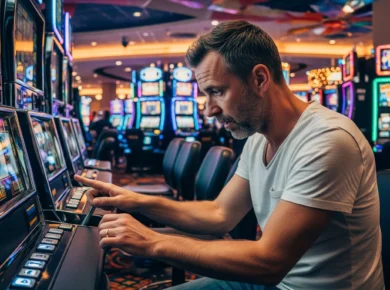Casino streaming and its rise in Asian gambling culture
Over the last decade, traditional gambling circles across Asia have steadily transformed, and the quiet revolution powering this change isn’t found in baccarat halls or Macau’s neon lights—it’s happening on livestreams. Casino streaming, once seen as a Western niche filled with loud personalities and flashy bets, has taken firm root in the Asian gambling psyche. It’s not just a trend; it’s become a cultural pivot. Gamblers nowadays no longer rely only on physically attending high-stake games or secretive VIP parlours. They’re glued to their phones and tablets, tuning into streamers spinning reels or slapping chips down on virtual tables. What’s changed is access—real-time, open access to layers of gameplay and strategy that were once available only to insiders. I’ve seen experienced bettors in Saigon and fresh-faced punters in Manila both dissecting streamers’ techniques with the fervour of boxing fans reviewing match tapes. It’s schooling and entertainment rolled into one interactive package. It’s also a double-edged sword.
The role of accessibility and identity in streaming’s popularity
The rise of mobile-first platforms across the continent, especially in regions like Vietnam and the Maldives, has opened the floodgates. Apps and digital hubs have become so efficient that even novice punters now possess livestreaming tools once reserved for production studios. Pair that with anonymous aliases and condensed content formats, and you’ve essentially granted anyone with decent internet a public gambling stage. This cultural shift is deep. In markets like Vietnam, where conventional gambling options are heavily restricted, streaming offers a loophole—not necessarily legal, but socially tolerated in many online circles. On platforms that operate under grey-area regulations, punters recreate roulette sessions and crypto-strategy games from the comforts of their living rooms. For example, many streamers build their content around foreign-regulated platforms, including giants like Bet365 Vietnam, as a safer and more reliable anchor for gameplay. This hybrid legality has become part of the game. The table is digital, but the stakes are very real.
Cultural adoption in Asia’s diverse gambling environments
Different markets across Asia have absorbed streaming culture with startling diversity. In Japan, the experience mirrors anime fandom—complete with themed avatars and personality-driven crews. In contrast, China's underground markets mirror a tactical arms race, where stream intelligence is dissected and monetised right down to betting intervals. The Philippines, meanwhile, sees an odd mix: a growing informal market feeding off livestreams while being actively courted by large legal casinos to adopt the format for their own branding. In the Maldives, restrictions are tighter. However, platforms like Bet365 Maldives have given curious players an alternative path, marrying the thrill of high-stakes Western-style gameplay with Asian user interfaces and themes. Interestingly, many streamers leverage loyalty rewards and tier-based incentives to retain viewership, mimicking real casino VIP experiences. Educational resources like VIP rewards systems are often dissected during streams, making viewers understand that streaming isn’t just about the rush—it’s about the long game.
Authenticity versus performance: the evolving expectations
Here’s where I’ll call out a common mistake the new crowd makes: treating casino streaming like some mindless, flashy show. Too many novice streamers chase clickbait titles and absurd gestures (think: slapping a fish on the desk after each win). But real gamblers—those watching to learn or make decisions—are looking for something else entirely: patterns, calm under pressure, and actual return-to-player analysis. They want maths, not memes. I’ve seen seasoned pros quietly turn off streams the moment a host starts off with “Let’s go crazy tonight!” because experienced players know something the beginners don’t: streaks are rare, bankroll management is king, and volatility will eat you alive if you’re not careful. Oddly enough, some of the most influential streamers now are introverts who approach gambling like a science, not a party.
The risks and regulatory limbo
Here in Asia, regulation’s playing catch-up. Most jurisdictions haven’t carved out specific laws for streaming yet—only for direct gambling action. This murky territory presents both opportunity and danger. Unregulated streaming environments can, and often do, drift into predatory behaviour. I've personally tracked streamers who manipulate live content with pre-recorded wins, luring viewers into platforms they get affiliate commissions from—without so much as a warning. That’s straight-up unethical. It’s not all doom and gloom, though. Some organisations have quietly started pushing for self-regulated ethics boards and streamer-backed transparency codes. The hope is to establish what I call “macro-honesty”: where your stream shows the full picture, not just winning clips and neon overlays. The potential for positive change is significant if Asian markets can harness this momentum while introducing common-sense legislation—think platform accountability, country-specific IP blocking, and visible odds ratios—we won’t just preserve trust. We’ll add decades of growth potential to this fascinating hybrid space.
Concluding thoughts: it’s not just a fad
Casino streaming in Asia isn’t going anywhere. It’s the natural evolution of an age-old thrill, updated for the digital arena. But let’s not forget what gambling truly demands: discipline, strategy, and respect for the game itself. Livestreaming is only a powerful new medium if handled with care. Treat it as a shortcut, and you'll burn out faster than a busted flush. Shade, style, and fast fingers may win audiences—but in gambling, it's the subtleties that separate real players from the wannabes. Learn to read a stream like you'd read a live table: look past the drama, clock the timing, assess the bankroll strategies, and spot the bluff behind the screen. That’s where the real action is.























